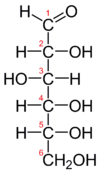Question #c77df
1 Answer
The only other one is L-Glucose...
Explanation:
For lack of a better description, the name Glucose is "reserved" for a specific Hexose.
(D-) Glucose:

If you "flip" any of the H- and OH chains bound to Carbon Atoms 2 to 5, then it isn't called Glucose anymore.
Example: (D-) Mannose.
Notice that the "horizontally bound" H- and OH groups on C2 are "flipped"...
Only if you flip ALL groups on carbons 2-5 , then you get the mirror image of the Glucose form as pictured above. This form (the mirror image) is called L-Glucose. D- and L-glucose are identical, but mirror images, and therefore not superimposable on each other.
With one or, possibly two exceptions, living organisms can NOT metabolize L-Glucose: due to its 3D-structure it can't be phosphorylated by Hexokinase, and therefore can't be broken down by the Embden Mayerhof pathway (Glycolysis).
Because of the body's inability to break it down it was once suggested as an artificial sweetener, but the production costs (it is not found in Nature) proved to be prohibitive.
It has been found to have laxative properties though, and has been suggested as a colon-cleansing agant for use in Colonoscopy.

